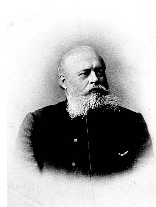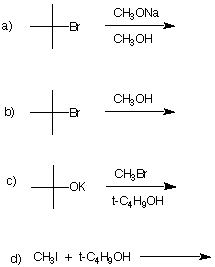|
Reading assignments: a)The alkene module in ORGO. How do I approach solving problems like #1---5?
Here is a step-by-step
analysis of a typical problem. |

Vladimir Vasilovich Markovnikov (1838-1904) |
|
2. Compound A, C7H12, affords a single ketoaldehyde B upon ozonolysis and dimethyl sulfide reduction. Hydrogenation of A gives methylcyclohexane and the reaction liberates 27.0 kcal/mol of heat. Treatment of A with HBr in the presence of peroxide gives two compounds, C and D. Compound C reacts with C2H5ONa/C2H5OH to give E while under the same conditions, compound D gives mainly A and some of compound E. Ozonolysis of E gives a single dialdehyde F. What are the structures of A-F? Explain and illustrate. Pay attention to stereochemistry. |
|
3. Compound A reacts with Br2 in CCl4 to give B. The intermediate in this reaction (C) is a meso species. Ozonolysis of A affords only propanal (propionaldehyde). What are the structures A-C? Explain and illustrate. Pay attention to stereochemistry. |
|
4. Optically active hydrocarbon A reacts with 2 molar equivalents of hydrogen to produce diastereomers B and C, both of which are optically inactive. Compound B has a smaller heat of combustion than C. Ozonolysis and dimethyl sulfide reduction of A affords pyruvaldehyde D (C3H4O2) and (S)-isopropylsuccindialdehyde E (tartaric acid = 2,3-dihydroxysuccinic acid). What are the structures A-E? What are the sign and value of the optical rotation of A (Review PS4)? Explain. |
|
5. Compound A (C10H20) undergoes ozonolysis to produce a single, optically active compound (R)-B. The reaction of compound A with ethereal OsO4 or aqueous KMnO4 provides a single compound C. On the other hand, treatment of compound A with Br2 in CCl4, affords two new compounds, D and E, both of which are optically active. There is insufficient information to distinguish between D and E. What are the structures of A-E? Show their stereochemistry. Show your reasoning. |
|
6. Provide the products, reagents, and/or reagents as required in each of the following problems. Explanations are required for all.
|
